
LOADING ...
In response to evolving domestic opinion, eMedals Inc has made the conscious decision to remove the presentation of German Third Reich historical artifacts from our online catalogue. For three decades, eMedals Inc has made an effort to preserve history in all its forms. As historians and researchers, we have managed sensitive articles and materials with the greatest of care and respect for their past and present social context. We acknowledge the growing sentiments put forth by the Canadian public and have taken proactive actions to address this opinion.
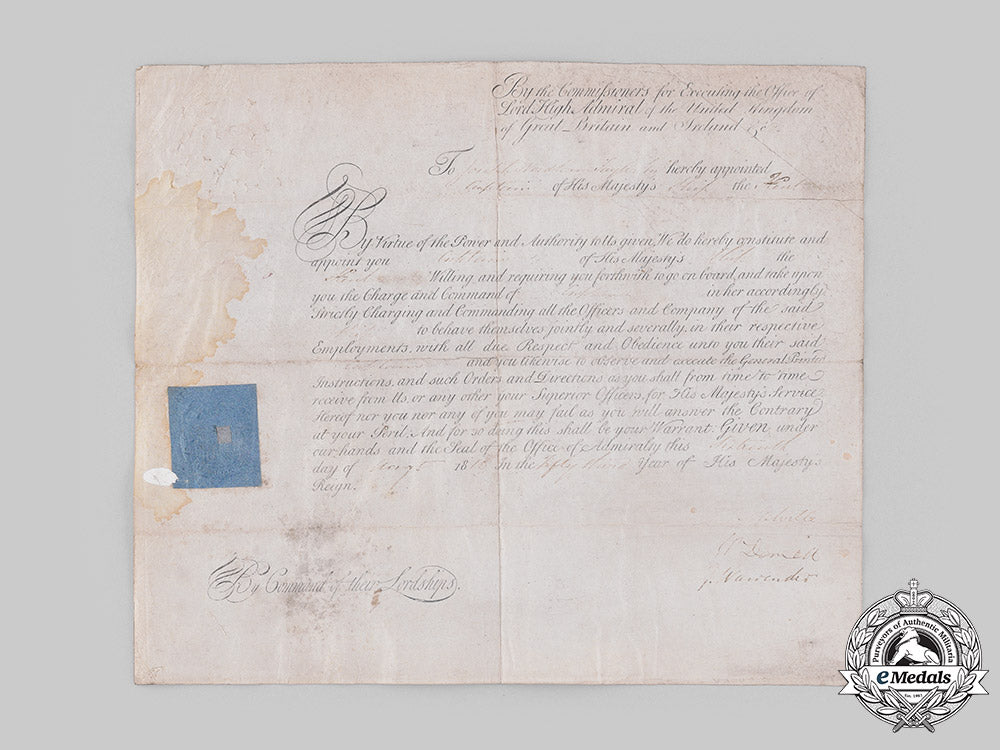
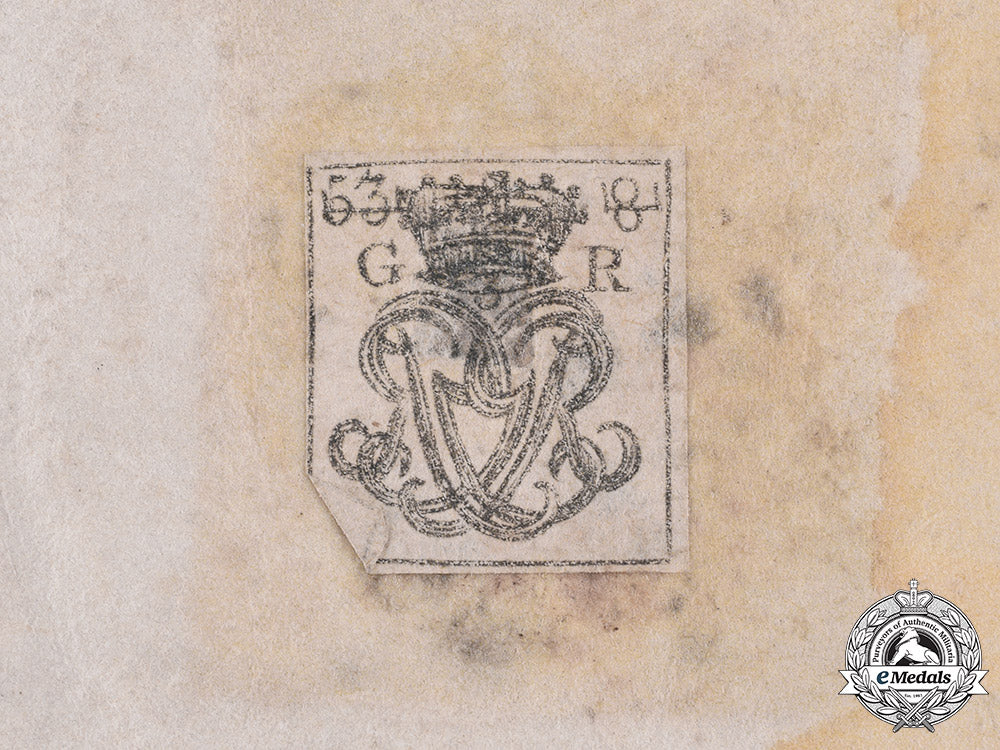
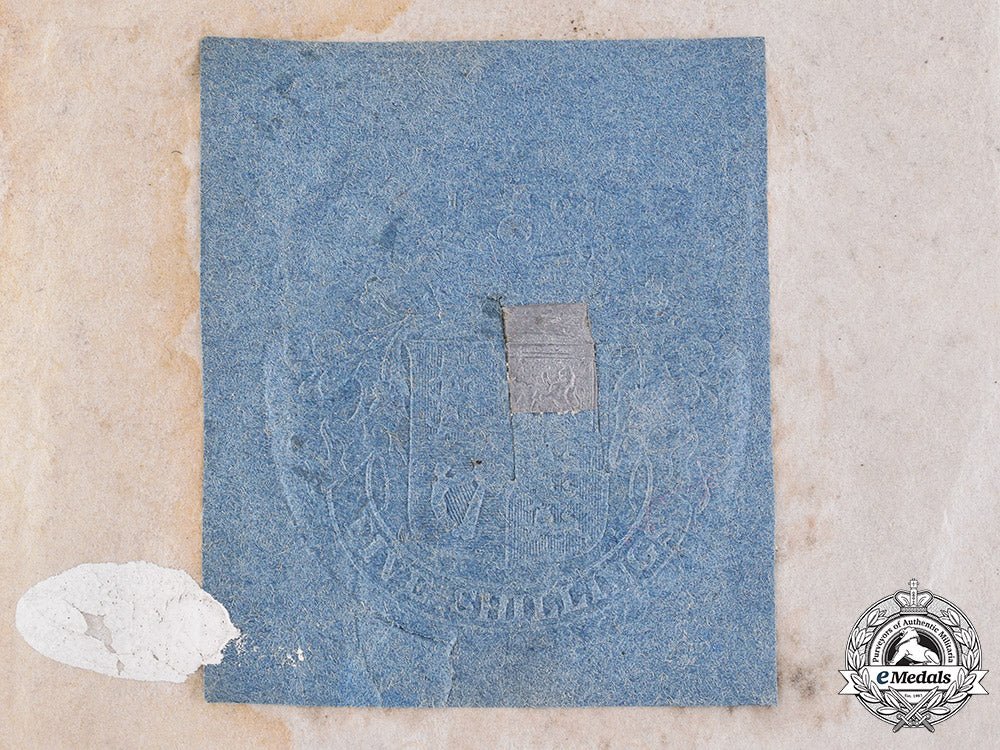
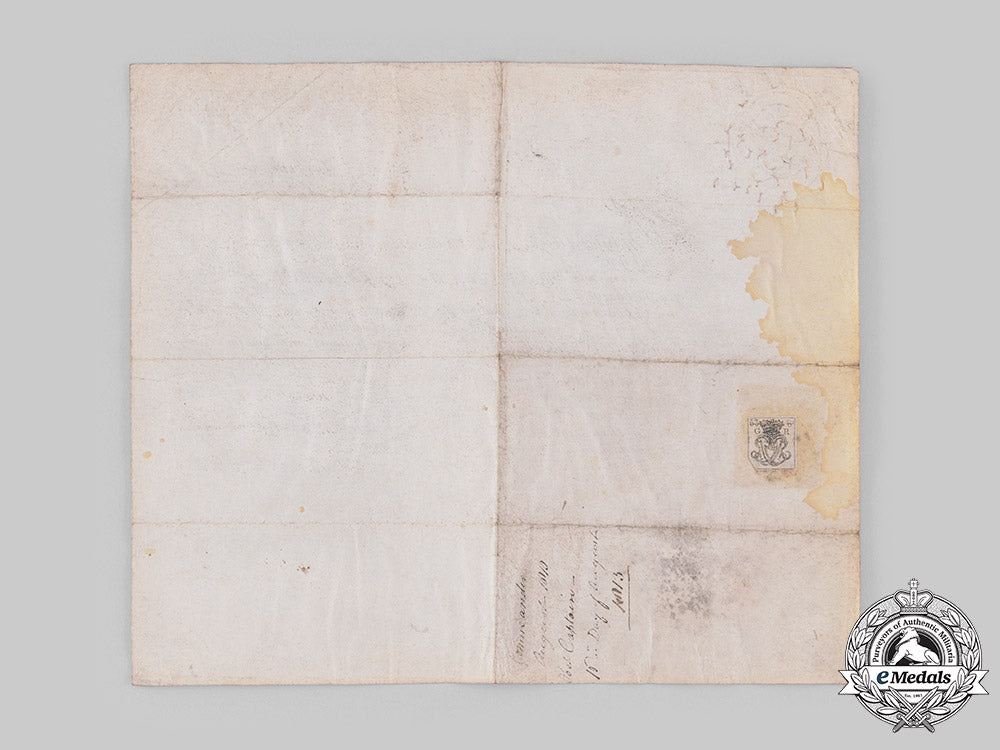
United Kingdom. A Napoleonic Captain Appointment Document Of The Hms Kent To Captain Joseph Needham Tayler, 1813.
United Kingdom. A Napoleonic Captain Appointment Document Of The Hms Kent To Captain Joseph Needham Tayler, 1813.
SKU: ITEM: GB6934
Current Bid:
Your Max Bid:
Bid History:
Time Remaining:
Couldn't load pickup availability
Shipping Details
Shipping Details
eMedals offers rapid domestic and international shipping. Orders received prior to 12:00pm (EST) will be shipped on the same business day.* Orders placed on Canadian Federal holidays will be dispatched the subsequent business day. Courier tracking numbers are provided for all shipments. All items purchased from eMedals can be returned for a full monetary refund or merchandise credit, providing the criteria presented in our Terms & Conditions are met. *Please note that the addition of a COA may impact dispatch time.
Shipping Details
eMedals offers rapid domestic and international shipping. Orders received prior to 12:00pm (EST) will be shipped on the same business day.* Orders placed on Canadian Federal holidays will be dispatched the subsequent business day. Courier tracking numbers are provided for all shipments. All items purchased from eMedals can be returned for a full monetary refund or merchandise credit, providing the criteria presented in our Terms & Conditions are met. *Please note that the addition of a COA may impact dispatch time.
Description
Description
United Kingdom. A vellum document to Joseph Needham Tayler, providing a Captain appointment to the HMS Kent, measuring 327mm (l) x 284mm (w), a five shillings duty stamp on blue paper with a tin strip is glued on the left side two thirds down the page, legible ink throughout, reverse bears handwriting script regarding Tayler “Commander August 1810 Post Captain 16 Day of August 1813” and stamp on reverse of duty stamp, the document is heavily creased into eight equal sessions, stained on left side, damage by way of several small slices to the top left hand corner, overall near very fine condition.
Born on August 15, 1783, at Devizes, Wiltshire, to six-time mayor and former commander of the Devizes Loyal Volunteers, Samuel Tayler and his wife Sally Needham, Joseph was the youngest of three sons. His oldest brother Samuel served as a lieutenant in the 13th Light Dragoons and was killed in Portugal. The middle son, Thomas, was a major in the Bengal 9th Native Infantry and died in India. Joseph would go on to become a Captain, commanding the HMS Sparrow and participate in numerous Napoleonic battles.
In July 1796, Tayler entered the Navy as a mid-shipman on the Royal George, under the command of Lord Bridport. By 1799, he was removed to the Anson frigate, captained by Sir Philip C. Durham. During this time, the Anson captured la Vainqueur, along with seven other Spanish merchant vessels. Tayler was involved with the musketry fire that resulted in the successful seizure of the ship. He earned his first commission as lieutenant on April 29, 1802. The following year he was aboard the Leopard 50, off the coast of Boulogne. He assisted in the capture of seven French gun vessels and stayed in the general location until Napoleon Bonaparte abandoned his long-desired goal of invaded Great Britain. Following this, the Leopard was ordered to escort the Honourable East India’s Company ships to the Cape Verd islands. In March of 1806, the Lady Burgess struck reef and began to sink. Lieutenant Tayler immediately and bravely offered his service to venture out in a 6-oar cutter and rescue the survivors.
Tayler’s next command was appointed on March 16, 1807, to the Maida 74. Tayler was given command of a party of seamen by Captain Samuel Hood Linzee. During this time, he participated in the breaching battery before Copenhagen, which resulted in the surrender of the Danish Navy. Over the years Tayler continued to serve aboard the Spencer 74, led by Rear-Admiral Sir Robert Stopford in the blockade of l’Orient, and the Heroine 32 captained by Hood Hanway Christian. It was in 1810 when he received his next appointment, joining the Goldfinch, a 10-gun brig, employed in aiding the Spanish patriots. He advanced to the rank of Commander on August 27, 1810, eventually joining the Sparrow brig in February of 1811.
The Sparrow was attached to a squadron sailing on the north coast of Spain. Captain Tayler proved immensely useful in surveying harbours, gathering intelligence on the strength of various French garrisons, and drawing plans of the enemy’s works. Shortly thereafter, the Sparrow joined Sir Home Popham’s squadron and participated in the subsequent destruction of numerous enemy fortifications including Bermeo, Plencia, Galea, Begona, El Campillo las Quersas, Xebiles and Castro. This brig was also involved in the attacks upon Puerta Galetta in July of 1812. Captain Tayler was stationed in the entrance of St. Andero harbour and his ship took heavy fire, resulting in one killed and three wounded, and a heavily damaged ship. The following day the ship was again engaged in enemy fire and was forced through a narrow passage, making a slight escape. In the summer of 1813, Tayler held a brief post as Captain of the brig Kent.
During the winter of 1813, the Sparrow gallantly defended Castro, and Captains Tayler’s actions were deemed particularly meritorious. Upon arrival at Castro, Captain Tayler noted the disembarking of the enemy, and their movement toward the castle. His ship had already prevented several cargoes of provisions from reaching the French. The British moved in to enfilade them in their retreat and the French quickly departed, resulting in the capture of the castle and its supplies including seven long guns, two carronades, two brass howitzers, power, shot and shells. For these actions, Captain Tayler’s “promptitude and zeal” were held in very high regard by Lord Keith and Sir George R. Collier.
The Battle of Vittoria took place the day before Captain Tayler’s recapture of the Castro Castle, and led to the siege of St. Sebastian, a key fortress for the farther operations of the campaign. Captain Tayler joined the forces by preparing a battery and mounting one of the Sparrow’s carronades. Struggling against the weather, it was two days before he could begin firing upon the enemy. On July 24th, he was directed to make a false attack on the hill of St. Sebastian, drawing attention away from the walls of the town. The French defence was too strong, and British casualties reach the 900s. The enemy then focused their fire upon Captain Tayler’s battery. He was injured by a falling shell which cut his forehead, and both bones of his left leg were fractured and protruding outwardly. He also received a dangerous wound to the groin. Following this serious injury, he was relieved by Captain John Campbell. His leg was saved by Dr. Andrew Baird, the Inspector of Naval Hospital, but was considered the most extensive injury the doctor had seen. Tayler was bed bound for twenty-eight weeks, and although his leg healed, it was considerably shortened, and was decidedly worse off than if it has been removed altogether.
Captain Tayler was promoted to post-captain on August 6, 1813 was also provided with a pension. He was nominated to a Companion of the Bath in October of 1815. The Patriotic Society provided Tayler with the monies to purchase a sword or vase, and the Corporation of Devises presented him with the freedom of the borough. He was well regarded as the first broadswordsman in the naval service, and many of his teachings were adopted aboard the Leopard, Maida, Spencer, Heroine, Goldfinch and Sparrow. He invented a carriage for transporting ship’s guns for field service, which was used by the naval brigade at Copenhagen.
In the 1830s, Tayler became a property developer in Devizes, building new shops and houses for the township, however, this venture did not provide a profit, and he was held in the Queen’s Bench Prison in 1842 for debt. He was a founding member of the Devizes Literary and Scientific Institution in 1833. H was officially retired from the navy in 1846. Tayler died at the age of 80, in Brixton, South London on March 18, 1864.
Description
United Kingdom. A vellum document to Joseph Needham Tayler, providing a Captain appointment to the HMS Kent, measuring 327mm (l) x 284mm (w), a five shillings duty stamp on blue paper with a tin strip is glued on the left side two thirds down the page, legible ink throughout, reverse bears handwriting script regarding Tayler “Commander August 1810 Post Captain 16 Day of August 1813” and stamp on reverse of duty stamp, the document is heavily creased into eight equal sessions, stained on left side, damage by way of several small slices to the top left hand corner, overall near very fine condition.
Born on August 15, 1783, at Devizes, Wiltshire, to six-time mayor and former commander of the Devizes Loyal Volunteers, Samuel Tayler and his wife Sally Needham, Joseph was the youngest of three sons. His oldest brother Samuel served as a lieutenant in the 13th Light Dragoons and was killed in Portugal. The middle son, Thomas, was a major in the Bengal 9th Native Infantry and died in India. Joseph would go on to become a Captain, commanding the HMS Sparrow and participate in numerous Napoleonic battles.
In July 1796, Tayler entered the Navy as a mid-shipman on the Royal George, under the command of Lord Bridport. By 1799, he was removed to the Anson frigate, captained by Sir Philip C. Durham. During this time, the Anson captured la Vainqueur, along with seven other Spanish merchant vessels. Tayler was involved with the musketry fire that resulted in the successful seizure of the ship. He earned his first commission as lieutenant on April 29, 1802. The following year he was aboard the Leopard 50, off the coast of Boulogne. He assisted in the capture of seven French gun vessels and stayed in the general location until Napoleon Bonaparte abandoned his long-desired goal of invaded Great Britain. Following this, the Leopard was ordered to escort the Honourable East India’s Company ships to the Cape Verd islands. In March of 1806, the Lady Burgess struck reef and began to sink. Lieutenant Tayler immediately and bravely offered his service to venture out in a 6-oar cutter and rescue the survivors.
Tayler’s next command was appointed on March 16, 1807, to the Maida 74. Tayler was given command of a party of seamen by Captain Samuel Hood Linzee. During this time, he participated in the breaching battery before Copenhagen, which resulted in the surrender of the Danish Navy. Over the years Tayler continued to serve aboard the Spencer 74, led by Rear-Admiral Sir Robert Stopford in the blockade of l’Orient, and the Heroine 32 captained by Hood Hanway Christian. It was in 1810 when he received his next appointment, joining the Goldfinch, a 10-gun brig, employed in aiding the Spanish patriots. He advanced to the rank of Commander on August 27, 1810, eventually joining the Sparrow brig in February of 1811.
The Sparrow was attached to a squadron sailing on the north coast of Spain. Captain Tayler proved immensely useful in surveying harbours, gathering intelligence on the strength of various French garrisons, and drawing plans of the enemy’s works. Shortly thereafter, the Sparrow joined Sir Home Popham’s squadron and participated in the subsequent destruction of numerous enemy fortifications including Bermeo, Plencia, Galea, Begona, El Campillo las Quersas, Xebiles and Castro. This brig was also involved in the attacks upon Puerta Galetta in July of 1812. Captain Tayler was stationed in the entrance of St. Andero harbour and his ship took heavy fire, resulting in one killed and three wounded, and a heavily damaged ship. The following day the ship was again engaged in enemy fire and was forced through a narrow passage, making a slight escape. In the summer of 1813, Tayler held a brief post as Captain of the brig Kent.
During the winter of 1813, the Sparrow gallantly defended Castro, and Captains Tayler’s actions were deemed particularly meritorious. Upon arrival at Castro, Captain Tayler noted the disembarking of the enemy, and their movement toward the castle. His ship had already prevented several cargoes of provisions from reaching the French. The British moved in to enfilade them in their retreat and the French quickly departed, resulting in the capture of the castle and its supplies including seven long guns, two carronades, two brass howitzers, power, shot and shells. For these actions, Captain Tayler’s “promptitude and zeal” were held in very high regard by Lord Keith and Sir George R. Collier.
The Battle of Vittoria took place the day before Captain Tayler’s recapture of the Castro Castle, and led to the siege of St. Sebastian, a key fortress for the farther operations of the campaign. Captain Tayler joined the forces by preparing a battery and mounting one of the Sparrow’s carronades. Struggling against the weather, it was two days before he could begin firing upon the enemy. On July 24th, he was directed to make a false attack on the hill of St. Sebastian, drawing attention away from the walls of the town. The French defence was too strong, and British casualties reach the 900s. The enemy then focused their fire upon Captain Tayler’s battery. He was injured by a falling shell which cut his forehead, and both bones of his left leg were fractured and protruding outwardly. He also received a dangerous wound to the groin. Following this serious injury, he was relieved by Captain John Campbell. His leg was saved by Dr. Andrew Baird, the Inspector of Naval Hospital, but was considered the most extensive injury the doctor had seen. Tayler was bed bound for twenty-eight weeks, and although his leg healed, it was considerably shortened, and was decidedly worse off than if it has been removed altogether.
Captain Tayler was promoted to post-captain on August 6, 1813 was also provided with a pension. He was nominated to a Companion of the Bath in October of 1815. The Patriotic Society provided Tayler with the monies to purchase a sword or vase, and the Corporation of Devises presented him with the freedom of the borough. He was well regarded as the first broadswordsman in the naval service, and many of his teachings were adopted aboard the Leopard, Maida, Spencer, Heroine, Goldfinch and Sparrow. He invented a carriage for transporting ship’s guns for field service, which was used by the naval brigade at Copenhagen.
In the 1830s, Tayler became a property developer in Devizes, building new shops and houses for the township, however, this venture did not provide a profit, and he was held in the Queen’s Bench Prison in 1842 for debt. He was a founding member of the Devizes Literary and Scientific Institution in 1833. H was officially retired from the navy in 1846. Tayler died at the age of 80, in Brixton, South London on March 18, 1864.
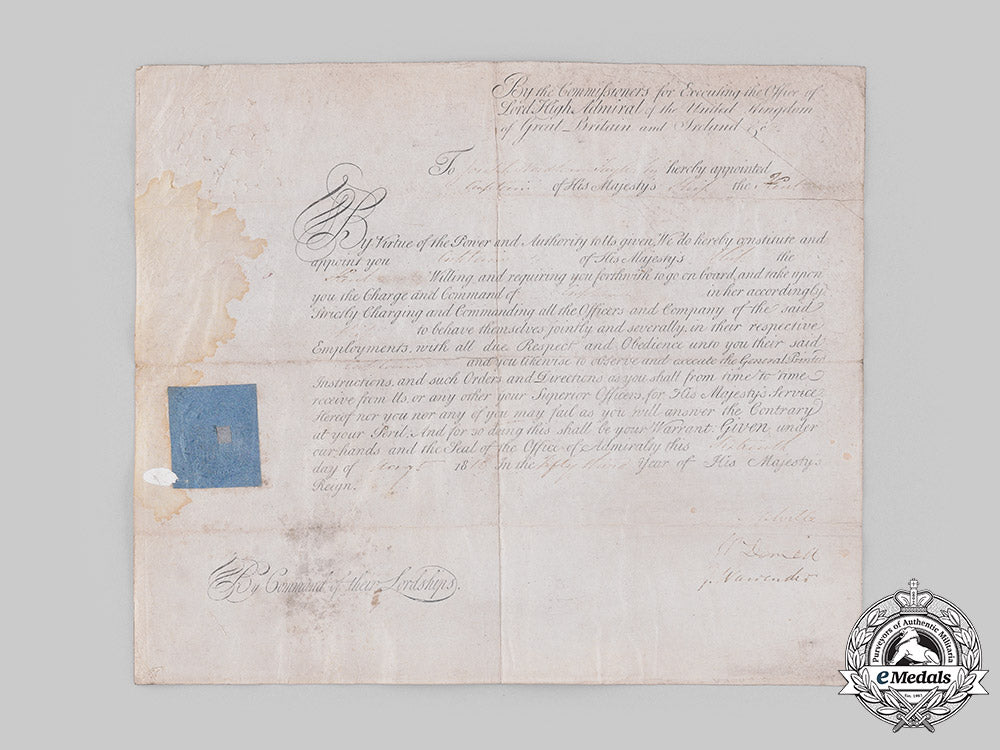
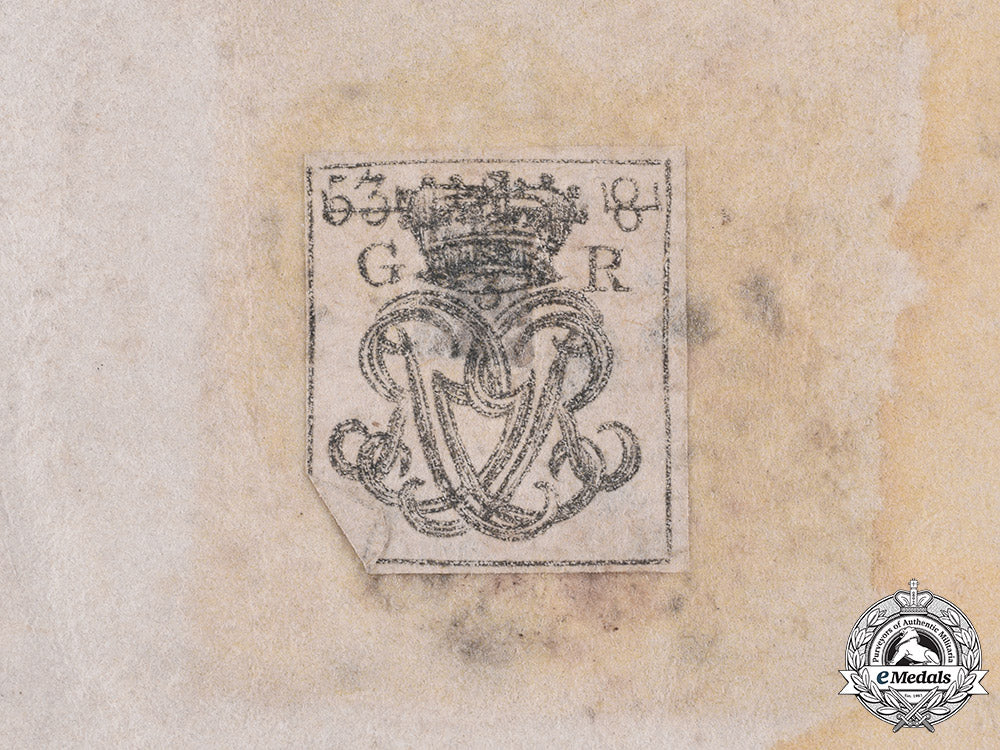
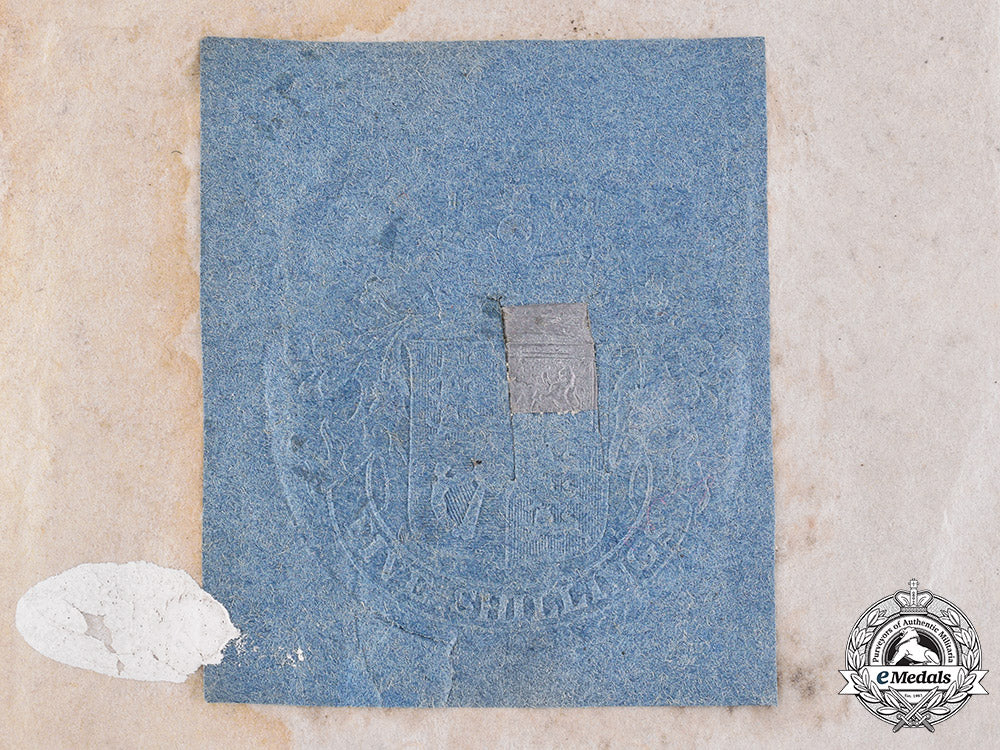
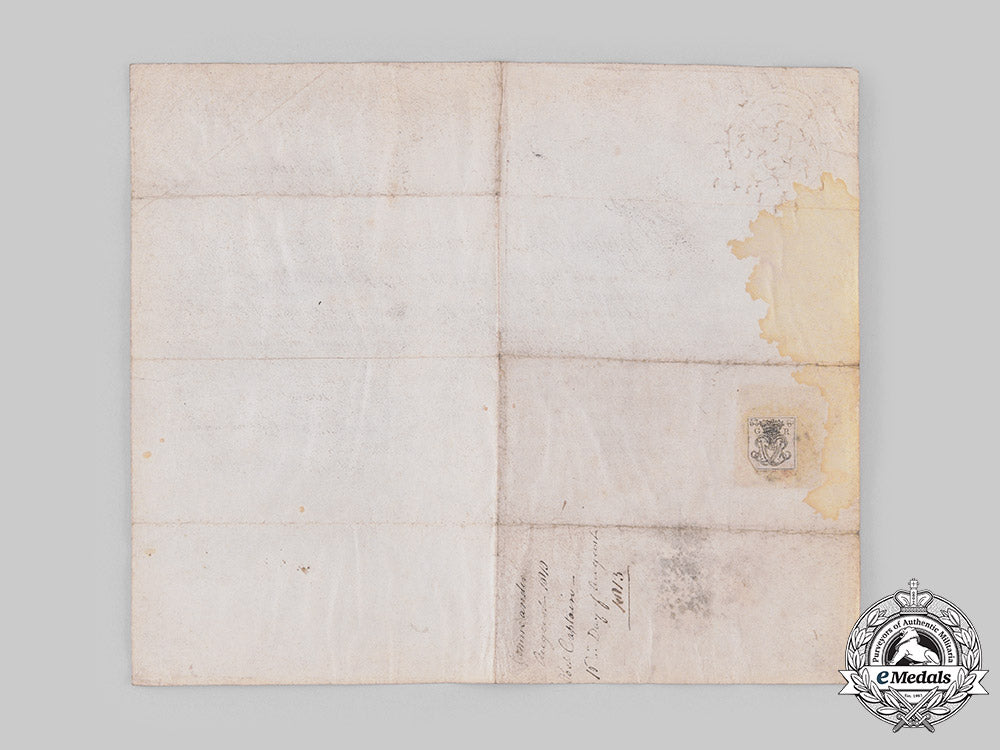
You May Also Like
eMedals Gift Card - $250
eMedals Gift Card - $500
eMedals Gift Card - $25
eMedals Gift Card - $50
Russia, Imperial. An Order of St. Vladimir, IV Class in Gold, Military Division, c.1905
EU24277
-
eMedals Gift Card - $250
Add to CartRegular price $250 USDRegular price USD Sale price $250 USDUnit price / per -
eMedals Gift Card - $500
Add to CartRegular price $500 USDRegular price USD Sale price $500 USDUnit price / per -
eMedals Gift Card - $25
Add to CartRegular price $25 USDRegular price USD Sale price $25 USDUnit price / per -
eMedals Gift Card - $50
Add to CartRegular price $50 USDRegular price USD Sale price $50 USDUnit price / per -
Russia, Imperial. An Order of St. Vladimir, IV Class in Gold, Military Division, c.1905
EU24277
Add to CartRegular price $3,450 USDRegular price $0 USD Sale price $3,450 USDUnit price / per
Do you have a similar item you are interested in selling?
Please complete the form and our client care representatives will contact you.
Sell Item












